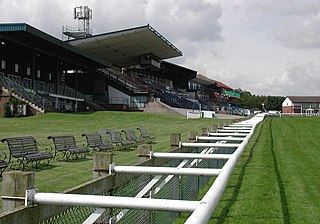
Aintree Racecourse is a racecourse in Aintree, Metropolitan Borough of Sefton, Merseyside, England, bordering the city of Liverpool. The racecourse is the venue for the Grand National steeplechase, which takes place annually in April over three days. Aintree also holds meetings in May, October (Sunday), November and December.

Newbury Racecourse is a racecourse and events venue in the civil parish of Greenham, adjoining the town of Newbury in Berkshire, England. It has courses for flat races and over jumps. It hosts one of Great Britain's 36 annual Group 1 flat races, the Lockinge Stakes.

Leicester Racecourse is a horse racing course in Oadby, Leicestershire, about three miles south of the city centre.

Sandown Park is a horse racing course and leisure venue in Esher, Surrey, England, located in the outer suburbs of London. It hosts 5 Grade One National Hunt races and one Group 1 flat race, the Eclipse Stakes. It regularly has horse racing during afternoons, evenings and on weekends, and also hosts many non-racing events such as trade shows, wedding fairs, toy fairs, car shows and auctions, property shows, concerts, and even some private events. It was requisitioned by the War Department from 1940-1945 for World War II. The venue has hosted bands such as UB40, Madness, Girls Aloud, Spandau Ballet and Simply Red. The racecourse is close to Esher railway station, served by trains from London Waterloo. There is a secondary exit from Esher station which is open on race days, this exit leads directly into the racecourse and Lower Green, Esher.

Kempton Park Racecourse is a horse racing track together with a licensed entertainment and conference venue in Sunbury-on-Thames, Surrey, England, on the border with Greater London; it is 13 miles west of Charing Cross in central London. The site has 210 acres of flat grassland surrounded by woodland with two lakes in its centre. Its entrance borders Kempton Park railway station which was created for racegoers on a branch line from London Waterloo, via Clapham Junction.

Ayr Racecourse at Whitletts Road, Ayr, Scotland, was opened in 1907. There are courses for flat and for National Hunt racing.

Haydock Park Racecourse is a racecourse in Merseyside, North West England. The racecourse is set in an area of parkland bounded by the towns of Haydock to the west, Ashton-in-Makerfield to the north, Golborne to the east and Newton-le-Willows to the south. Horse racing had been run in Newton for many years, and the venue was also used for hare coursing in the 1880s. The current racecourse was opened in 1899. Much of the course's early development was overseen by Sydney Sandon, who served as course secretary, chairman and managing director in the early 20th century.

Wetherby Racecourse is a racecourse situated near the market town of Wetherby in West Yorkshire, England, located 12 miles (19 km) from Leeds city centre. For most of its history the course has hosted only National Hunt racing but staged its first Flat racing fixture on 26 April 2015.

Brighton Racecourse is an English horse racing venue located a mile to the northeast of the centre of Brighton, Sussex, owned by the Arena Racing Company.

Bath Racecourse is a thoroughbred horse racing venue on Lansdown Hill, about 3+1⁄4 miles (5.2 km) northeast of Bath, Somerset, England. It is owned and operated by Arena Racing Company.

Beverley Racecourse is a thoroughbred horse racing venue located in the town of Beverley in the East Riding of Yorkshire, England.
Chepstow Racecourse is a thoroughbred horse racing course located just north of the town of Chepstow in Monmouthshire, Wales, near the southern end of the Wye Valley and close to the border with England. It is one of 16 racecourses operated by the Arena Racing Company and is home of the richest race in Wales, the Coral Welsh Grand National.

Musselburgh Racecourse is a horse racing venue located in the Millhill area of Musselburgh, East Lothian, Scotland, UK, close to the River Esk. It is the second biggest racecourse in Scotland and is the fourteenth biggest in the UK. In 2016, Musselburgh staged 28 fixtures. It was officially known as "Edinburgh Racecourse", and referred to as such in the English press, until the beginning of 1996 but was widely referred to as "Musselburgh" in Scotland long before that and was widely referred to as Musselburgh in the racing pages of Scottish newspapers.

Nottingham Racecourse is a thoroughbred horse racing venue located in Nottingham, Nottinghamshire, England. It is situated at Colwick Park, close to the River Trent and about 3 km east of the city centre.

Pontefract Racecourse is a thoroughbred horse racing venue located in Pontefract, West Yorkshire, England.
Sedgefield Racecourse is an English left-handed horse racing course, used for jump racing. It is owned by Arena Racing Company and located close to the town of Sedgefield, County Durham.
Fleet, known in the United States as Fleet II, was an Irish-bred, British-trained Thoroughbred racehorse and broodmare who won the classic 1000 Guineas in 1967. In a racing career lasting from June 1966 until July 1967, the filly contested nine races and won five times. As a two-year-old in 1966, Fleet won two of her three races including the Cheveley Park Stakes and was the highest rated filly of her age in Britain. In the following year she won three races over a distance of one mile including the 1000 Guineas and the Coronation Stakes. When tried over longer distances she finished fourth in The Oaks and Eclipse Stakes. She was retired to stud where she had some success as a broodmare in Britain and the United States.

Stockton Racecourse, also known as Teesside Park, was a British horse racing venue near Thornaby-on-Tees in the North Riding of Yorkshire England, once considered "the finest in the north".

Lanark Racecourse was a Scottish horse racing venue, situated in the small town of Lanark in Scotland's Central Belt, 25 miles (40 km) from Glasgow. It was reputedly founded by King William the Lion of Scotland (1165-1214).
















